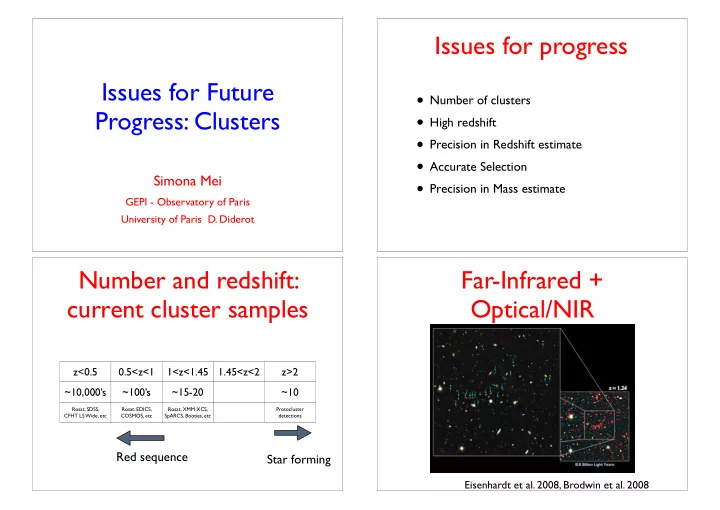

Issues for progress Issues for Future • Number of clusters Progress: Clusters • High redshift • Precision in Redshift estimate • Accurate Selection Simona Mei • Precision in Mass estimate GEPI - Observatory of Paris University of Paris D. Diderot Number and redshift: Far-Infrared + current cluster samples Optical/NIR z<0.5 0.5<z<1 1<z<1.45 1.45<z<2 z>2 ~10,000’s ~100’s ~15-20 ~10 Rosat, SDSS, Rosat, EDICS, Rosat, XMM XCS, Protocluster CFHT LS Wide, etc COSMOS, etc SpARCS, Booties, etc detections Red sequence Star forming Eisenhardt et al. 2008, Brodwin et al. 2008
SpARCS X-ray selected Stanford et al. 2005, se also Mullis et al. 2005 (Wilson et al. 2009; Muzzin et al 2009) Precision in redshift: Redshift range Cluster redshift z=1.3 • Galaxy clusters at 0.5<z<1.3 have a well defined red sequence, e.g. a dominant early- type population • Photometric redshifts, averaged on cluster candidates have reasonable statistical uncertainties • Projection effects (Mock catalogs, e.g. SDSS)
Precision in Mass estimate • X-ray : Flux/Temperature (Arnaud et al. 2007) • Weak and strong lensing Precision in photometric redshift of few hundreds of magnitude Mei et al. 2009 X-ray Mass Number Selection Precision High z in z SZ Optical multiband
X-ray Surveys Optical Surveys: wide • XMM Cluster Survey (current, 500 up to z~1 deg.sq.) • e-Rosita (all-sky; >2012) • PAN-STARRS (current; 30,000 sq.deg. up to • Wide Field X-ray Telescope (half sky; z~1-1.5; g,r,iz,y) >2020) • DES (current; 5000 sq. deg. up to z~1; g,i,r,z) • LSST (>2015; 20,000 sq.deg up to z~1-1.5; Targeted Observations for Flux and Temperature u,g,r,i,z,y) precision measurements • XMM, Chandra (current) • IXO (>2020) SZ Wide Surveys Combined Optical/X-ray, SZ • SPT (Oct 2008, first cluster detected from SZ observations; 4000 sq. deg. up to z~1-2) Studies • ACT (400 sq. deg., up to z~1-2) • SPT (Blanco Cosmology Survey, DES) • Planck (All sky, up to z~1) • ACT (Blanco Cosmology Survey, GALEX) Targeted Observations for precision measurements • Planck (All sky up to z~1, SDSS, and dedicated follow-up) • AMI, AMEBA, SZA, APEX
Planck X-ray follow-up Planck Optical follow-up Fromenteau et al. 2009
Recommend
More recommend